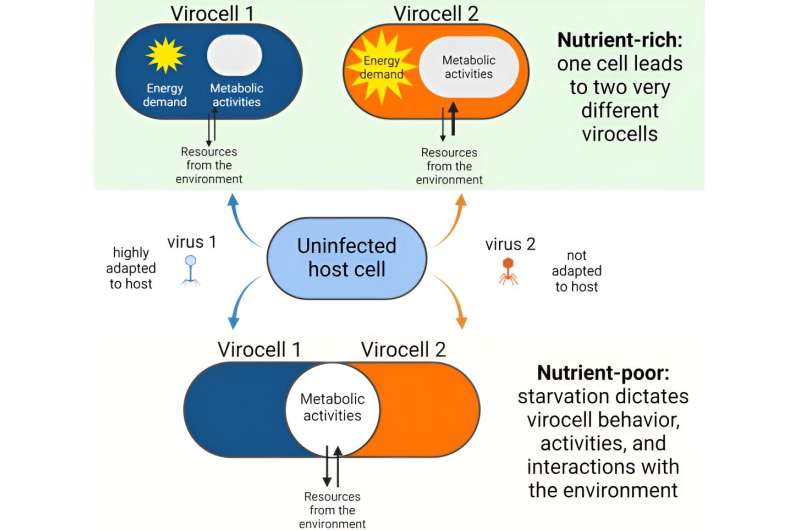This article has been reviewed according to Science X's editorial process and policies. Editors have highlighted the following attributes while ensuring the content's credibility:
fact-checked
peer-reviewed publication
trusted source
proofread
A merger of microbes: Study shows low-nutrient conditions alter viral infection

This much we know: When viruses infect bacteria—a common occurrence in oceans, soils, even human guts—the interaction results in the creation of entirely new organisms called "virocells." But scientists are still learning about how this merger of microbes affects, and is affected by, their surroundings.
Four years ago, scientists made a surprising lab discovery about ocean bacteria that were infected by two different viruses: The infections resulted in two very different virocells whose functions were governed wholly by viral needs rather than their bacterial origins.
"So they're operating differently even though it was the same parent cell. You had the same entity become two different entities from two different viruses," said Cristina Howard-Varona, a research scientist in microbiology at The Ohio State University and the first author of the study. "This is fascinating, because viral infections are happening all the time."
The finding was made under experimental conditions considered best for observing a previously unknown phenomenon—which included high levels of the nutrient phosphate in the water. Howard-Varona and colleagues have repeated the work in a new study under low-phosphate conditions more similar to the natural world, where pockets of the ocean are starved of nutrients.
They found that these real-world conditions made a huge difference in how viral infection affected the host bacteria—so much so that the two types of infected cells are represented in the paper as a Venn diagram to show the functions and characteristics they share alone or in combination as a result of their low-nutrient environment.
The study was published recently in The ISME Journal.
The point of the new findings is not only about how the two virocells behave individually in a low-phosphate area of the ocean, but also about how much impact the environment has on the routine event of viruses infecting bacteria.
"When you deplete only one nutrient, it has a drastic impact—it changes the picture of infection even though it's the same cell and the same viruses as in the earlier study," Howard-Varona said.
"So what would happen if we starved it even more or we deplete a different nutrient? This tells us it's going to be very important to study cells and virocells under nutrient conditions that more closely resemble what they encounter in nature."
The research has potential to improve large-scale modeling of ocean microbial systems, which to date tends to lack the virocell component, said Matthew Sullivan, co-senior author of both studies and a professor of microbiology at Ohio State.
"If we are to predict how organisms contribute to ocean geochemistry, we need to know how cell populations interact, how they obtain nutrients from the environment and how that changes the composition of organic matter that makes the cells—and how everything together contributes to climate change and to the oceans' response to climate change," said Sullivan, also a professor of civil, environmental and geodetic engineering and founding director of Ohio State's Center of Microbiome Science.
"The same is true of modeling microbes in soils, which don't have a nutrient-rich environment, either, and where we know very little about virocells and how they contribute to the health of roots and crops."
In the new study, researchers found that the two infecting viruses did wield plenty of control over functions that dominated the two resulting virocells.
The viruses, called phages, were selected for their very different qualities: One is very genomically similar to the host bacteria, so it focused on recycling existing resources, and the other, less similar phage had to work harder to generate resources. In both cases, the aim is to access energy and maximize making viral copies and eventually killing the host.
"But those differences were narrowed in the low-phosphate environment, so they're less important—suggesting the environment may have a stronger effect than the infecting viruses on how virocells behave," Howard-Varona said.
And then there were activities common to both virocells in response to the starvation: activating a cell-wide stress response, obtaining energy from metabolizing fats rather than carbs, and reducing the amount of organic matter they consume from the environment.
"Every cell in the world needs phosphate to make DNA and energy, and so without it, there's no life, no function, no metabolism," Howard-Varona said. "And what we've shown is that in these conditions, virocells have commonalities. They sense the nutrient limitation and behave more similarly than they did when they were growing in a nutrient-rich environment.
"The environment is very important to viral infections—and so you can imagine this is true for every environment."
The researchers will be applying much of what they've learned from the marine environment to studies of soil virocells.
Co-authors include Azriel Krongauz, Natalie Solonenko, Ahmed Zayed and Subhadeep Paul of Ohio State; co-first author Morgan Lindback and co-senior author Melissa Duhaime of the University of Michigan; Jane Fudyma and Malak Tfaily of the University of Arizona; William Andreopoulos and Tijana Glavina del Rio of the DOE; and Heather Olson, Young-Mo Kim, Jennifer Kyle and Joshua Adkins of the Pacific Northwest National Laboratory.
More information: Cristina Howard-Varona et al, Environment-specific virocell metabolic reprogramming, The ISME Journal (2024). DOI: 10.1093/ismejo/wrae055
Journal information: ISME Journal
Provided by The Ohio State University





















